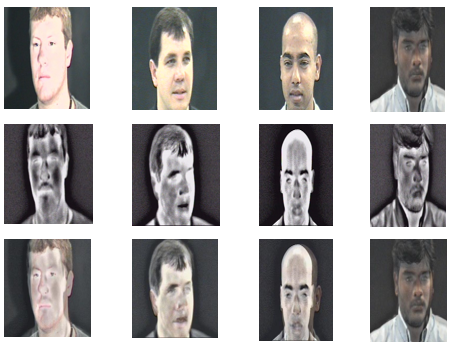Enhancing Face Recognition Performance with Multispectral Imaging and Machine Learning: Comparison from Sift and Sift-Freak Feature Extraction
Main Article Content
Abstract
The development of modern societies faces many security and identification challenges. To meet this expectation, computer vision offers biometric solutions. Much research in recent years has focused on face recognition. Traditional facial recognition that uses color images has had many shortcomings, such as variation in illumination, smoke, rain, disguise, face concealment, makeup, etc. Light-insensitive infrared (IR) imaging is presented as an alternative to facial recognition in the visible to overcome the shortcomings of uncontrolled environments. However, IR also has weaknesses, such as facial occlusion by glasses, variation in body temperature, perfusion, etc. This paper proposes a new facial recognition architecture that uses several classification algorithms, detectors, and feature descriptors in multispectral imaging. A combination of SIFT and FREAK, feature extraction tools, was associated with classification algorithms such as SVM, logistic regression, and Random forest to conduct this study. Several experiments were made to evaluate the performance of the proposed recognition system. The validation process of the proposed multispectral face recognition method involved several important steps. First, experiments were carried out on visible and infrared spectrum images to measure the recognition system's performance. These experiments made it possible to compare the recognition performances between these two types of images. Then, fuse visible and infrared images were used to assess multispectral facial recognition. The goal was to maximize each spectrum's advantages while minimizing their disadvantages. Metrics were evaluated to measure the accuracy of the multispectral face recognition method. The performances were compared with classical facial recognition methods, such as facial recognition based on the visible spectrum or infrared imagery alone. The results showed that the proposed multispectral facial recognition method performed better than traditional methods, reaching a facial recognition score ranging from 76% to 95% in the IRIS database.
Article Details
References
D. Mamadou, K. J. Ayikpa, A. B. Ballo, et B. M. Kouassi, « Application of Three Convolutional Neural Network Algorithms for Occluded Face Identification and Recognition for System Security », Am. J. Multidis. Res. Innov., vol. 1, no 5, p. 24?32, oct. 2022, doi: 10.54536/ajmri.v1i5.740.
D. Lu et L. Yan, « Face Detection and Recognition Algorithm in Digital Image Based on Computer Vision Sensor », Journal of Sensors, vol. 2021, p. e4796768, sept. 2021, doi: 10.1155/2021/4796768.
« The real world impact of facial detection and recognition », University of York, 14 avril 2022. https://online.york.ac.uk/the-real-world-impact-of-facial-detection-and-recognition/ (consulté le 6 mai 2023).
M. K. Bhowmik et al., « Thermal Infrared Face Recognition – A Biometric Identification Technique for Robust Security system », in Reviews, Refinements and New Ideas in Face Recognition, IntechOpen, 2011. doi: 10.5772/18986.
M. G. Forero et al., « Comparative Analysis of Detectors and Feature Descriptors for Multispectral Image Matching in Rice Crops », Plants, vol. 10, no 9, Art. no 9, sept. 2021, doi: 10.3390/plants10091791.
Y. Ke et R. Sukthankar, « PCA-SIFT: a more distinctive representation for local image descriptors », Proceedings of the 2004 IEEE Computer Society Conference on Computer Vision and Pattern Recognition, 2004. CVPR 2004., 2004, Consulté le: 14 mai 2023. [En ligne]. Disponible sur: https://www.semanticscholar.org/paper/PCA-SIFT%3A-a-more-distinctive-representation-for-Ke-Sukthankar/5a46f093f587eaa29c4d87c755b4b1fa3eabecdb
L. Daoud, M. K. Latif, H. S. Jacinto, et N. Rafla, « A fully pipelined FPGA accelerator for scale invariant feature transform keypoint descriptor matching », Microprocessors and Microsystems, vol. 72, p. 102919, févr. 2020, doi: 10.1016/j.micpro.2019.102919.
A. Pareek et N. Arora, « Evaluation of Feature Detector-Descriptor Using RANSAC for Visual Tracking ». Rochester, NY, 23 février 2019. doi: 10.2139/ssrn.3354470.
M. El-Abed, C. Charrier, et C. Rosenberger, « Évaluation de la qualité de données biométriques morphologiques », présenté à colloque COmpression et REprésentation des Signaux Audio-visuels (CORESA), 2012, p. 6 pages. Consulté le: 14 mai 2023. [En ligne]. Disponible sur: https://hal.science/hal-00806229
Z. Fan et al., « ASP-SIFT: Using Analog Signal Processing Architecture to Accelerate Keypoint Detection of SIFT Algorithm », IEEE Transactions on Very Large Scale Integration (VLSI) Systems, vol. 28, no 1, p. 198?211, janv. 2020, doi: 10.1109/TVLSI.2019.2936818.
https://vcipl-okstate.org/pbvs/bench/
Y. Kortli, M. Jridi, A. Al Falou, et M. Atri, « Face Recognition Systems: A Survey », Sensors (Basel), vol. 20, no 2, p. 342, janv. 2020, doi: 10.3390/s20020342.
S. Fekri-Ershad, « TEXTURE IMAGE ANALYSIS AND TEXTURE CLASSIFICATION METHODS - A REVIEW », vol. 2, 2019.
M. Diarra, P. Gouton, et K. J. Adou, « A Comparative Study of Descriptors and Detectors in Multispectral Face Recognition », in 2016 12th International Conference on Signal-Image Technology & Internet-Based Systems (SITIS), Naples: IEEE, 2016, p. 209?214. doi: 10.1109/SITIS.2016.41.
M. Diarra, P. Gouton, A. K. Jérôme, P. Gouton, et A. K. Jérôme, « Assessing the useful of similarity measures for multispectral face recognition », Electronic Imaging, vol. 30, p. 1?6, janv. 2018, doi: 10.2352/ISSN.2470-1173.2018.16.COLOR-361.
« Distinctive Image Features from Scale-Invariant Keypoints | SpringerLink ». https://link.springer.com/article/10.1023/B:VISI.0000029664.99615.94 (consulté le 28 mai 2023).
« Scale-Invariant Feature Transform - an overview | ScienceDirect Topics ». https://www.sciencedirect.com/topics/computer-science/scale-invariant-feature-transform (consulté le 14 mai 2023).
A. Alahi, R. Ortiz, et P. Vandergheynst, « FREAK: Fast Retina Keypoint », in 2012 IEEE Conference on Computer Vision and Pattern Recognition, juin 2012, p. 510?517. doi: 10.1109/CVPR.2012.6247715.
M. G. Forero et al., « Comparative Analysis of Detectors and Feature Descriptors for Multispectral Image Matching in Rice Crops », Plants (Basel), vol. 10, no 9, p. 1791, août 2021, doi: 10.3390/plants10091791.
K. J. Ayikpa, K. J. Ayikpa, K. J. Ayikpa, D. Mamadou, P. Gouton, et K. J. Adou, « Experimental Evaluation of Coffee Leaf Disease Classification and Recognition Based on Machine Learning and Deep Learning Algorithms », Journal of Computer Science, vol. 18, no 12, p. 1201?1212, déc. 2022, doi: 10.3844/jcssp.2022.1201.1212.

